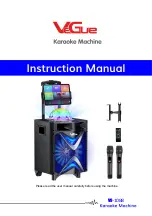
-4-
H8155 MIG Welder
4. ELECTRIC SHOCK.
DO NOT touch live
electrical parts. Connect welder to power
source with approved earth ground. Make
sure all electrical connections are tight,
clean, and dry. Connect workpiece to
approved earth ground. The work lead is
NOT a ground connection and is to be used
only to complete the working welding cir-
cuit.
5. PREVENT FIRES.
Welding work zones
must be kept clear of flammable liquids,
such as gasoline and solvents; combus-
tible solids, such as paper and wood; and
flammable gases, such as acetylene and
hydrogen. Provide approved fire barriers
and fire extinguishing equipment for the
welding zone. Stay alert for sparks and
spatter thrown into cracks and crevices that
can start a smoldering fire. Inspect the work
area again one hour after welding for any
potential fire hazards.
6. PROTECT BODY FROM ARC BURNS,
SPARKS, AND SPATTER.
Wear correct
and approved eye, ear, and body protec-
tion. Wear complete body protection, such
as clean and oil-free protective clothing,
leather gloves, protective cap, heavy long-
sleeve shirt, cuffless pants, and high leather
boots. DO NOT wear jewelry or frayed
clothing. Use a welding helmet with the cor-
rect shade of filter for the operation. Protect
other people and property in your work-
ing zone from exposure to arc radiation,
sparks, and spatter.
7. WORKING AREA.
Keep working area clear
of any material not involved in the welding
operation. Keep all equipment, workpieces,
and work surfaces clean, dry, and free of
entanglements. Keep lead cables orga-
nized and away from your body.
8. AVOID EXPLOSION HAZARD.
Never
weld on closed containers or containers
with fumes inside. Containers should be
prepared per American Welding Society
Publication F4.1, Section 7.
9.
HANDLING GAS CYLINDERS.
Regardless
of content, pressurized gas cylinders can
explode. Always secure a protector cap in
place over the outlet valve assembly when
moving the cylinder. A broken off valve
could release the pressurized contents and
cause the cylinder to be hurled about at
dangerously high speeds, causing serious
property damage, personal injury, or death.
Always use safe methods when moving gas
cylinders. Always secure a gas cylinder to a
wall or approved cylinder cart with a chain
before using or storing.
10.
PROTECT GAS CYLINDERS FROM HEAT
OR DAMAGE.
An excess of heat can
cause the pressurized gas to expand and
explode the cylinder. Never weld on the
gas cylinder. Damaging the outside of the
cylinder can cause the cylinder to crack and
explode. Exploding pressurized gas cylin-
ders can cause serious property damage,
personal injury, or death.
11. ELECTRIC AND MAGNETIC FIELDS
(EMF).
Welding operations create EMF
around the welding equipment and
workpieces. Workers who have pacemak-
ers must consult with their physician before
using this equipment or being within 50 feet
of welding operations.
12. EQUIPMENT MAINTENANCE.
Make sure
equipment inspections and maintenance
are performed by a qualified person as
required. Stop the welding operation and
disconnect the welder from power if the
equipment is damaged or malfunctions.
13. EXPERIENCING DIFFICULTIES.
If you
are experiencing difficulties performing the
intended operation, stop using the equip-
ment. Contact our Technical Support
Department at (570) 546-9663.
Содержание H8155
Страница 2: ... ...
Страница 19: ...H8155 MIG Welder 17 NOTES ...
Страница 20: ... 18 H8155 MIG Welder NOTES ...
Страница 21: ... ...
Страница 22: ... ...
Страница 24: ... ...







































